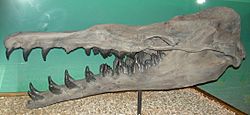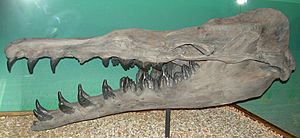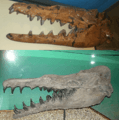Basilosaurus facts for kids
Quick facts for kids BasilosaurusTemporal range: Late Eocene
|
|
|---|---|
 |
|
| A skull of Basilosaurus cetoides | |
| Scientific classification | |
| Kingdom: | |
| Phylum: | |
| Class: | |
| Order: | |
| Suborder: | |
| Family: |
Basilosauridae
|
| Subfamily: |
Basilosaurinae
Cope, 1868
|
| Genus: |
Basilosaurus
Harlan, 1834
|
Basilosaurus was a type of ancient whale that lived about 40 to 34 million years ago. This was during a time called the Late Eocene epoch. The very first Basilosaurus fossils were found in Louisiana, USA. Later, many more fossils of a different Basilosaurus species were discovered in Egypt.
When the first fossil of Basilosaurus cetoides was found in the United States, scientists thought it was a giant reptile. That's why its name ends with "-saurus," like a dinosaur! But they soon realized it was actually a huge marine mammal. A scientist named Richard Owen wanted to change its name to Zeuglodon, meaning "yoked tooth." However, rules in science meant the first name, Basilosaurus, had to stay. Fossils of another species, B. isis, have been found in Egypt and Jordan. A third species, B. drazindai, was identified from a single bone found in Pakistan.
Basilosaurus was not a reptile at all. It was an important step in the evolution of whales. At 40 to 65 feet (12 to 20 meters) long, Basilosaurus cetoides was one of the biggest ocean animals of its time.
Contents
What Was Basilosaurus Like?
Basilosaurus cetoides was one of the largest animals on Earth for millions of years. It lived after the dinosaurs died out and before modern whales grew to their enormous sizes. It could be as long as 15 to 18 meters (about 50 to 60 feet). The species B. isis was a bit smaller than B. cetoides.
Its Head and Teeth

The head of Basilosaurus was different from modern toothed whales. It didn't have a special fatty organ called a melon, which modern whales use for echolocation. Its brain was also smaller compared to its body size. Scientists don't think Basilosaurus had the same social skills as whales today.
Basilosaurus could hear well underwater. Its skull was slightly uneven, similar to modern toothed whales. This unevenness helps whales make and hear high-frequency sounds. However, scientists don't believe Basilosaurus used echolocation like modern whales do.
Recent studies show that Basilosaurus isis had an incredibly strong bite. It could bite down with a force of over 3,800 to 4,500 pounds per square inch! This was likely the strongest bite force of any mammal. Scientists believe it used this power to crack open the skulls of young Dorudon, which were smaller ancient whales. This suggests Basilosaurus isis was an active hunter, not just an animal that ate dead things.
Its Long Body
A complete Basilosaurus skeleton was found in 2015. Scientists have put together its backbone from several fossils. It had about 70 bones in its spine.
Basilosaurus had a very long, eel-like body shape. This was because many of its backbones were stretched out. These long bones were filled with marrow, which made them float easily. This suggests that Basilosaurus mostly swam near the surface of the ocean. It probably moved by wiggling its body up and down, like an eel. The tail likely had a small fluke, or fin, that helped with this up-and-down movement. Most pictures show it with a small fin on its back, but some show just a ridge.
Tiny Hind Legs
Even though Basilosaurus was huge, it had tiny hind legs. An individual that was 16 meters (about 52 feet) long had hind limbs only 35 centimeters (about 14 inches) long. These small legs were not connected to its spine and couldn't have been used for swimming or moving on land. They were likely just leftover parts from its ancestors that lived on land.
How Basilosaurus Lived
How It Moved
Basilosaurus probably moved in a unique way compared to other whales. Its long, eel-like body meant it likely swam by moving its body up and down. Some scientists think it might have also moved side-to-side a little, which is very unusual for whales.
Its bones suggest that Basilosaurus was not built for long, fast swimming or deep dives. It probably stayed closer to the ocean surface.
What It Ate
The teeth of Basilosaurus were complex and showed signs of heavy wear. This means it chewed its food before swallowing. Scientists studied bite marks on the skulls of smaller ancient whales called Dorudon. They found that these marks matched the teeth of Basilosaurus. This suggests that Basilosaurus was a powerful predator.
Studies of what was found in the stomachs of B. cetoides fossils show that this species ate only fish and sharks. However, B. isis seems to have preferred hunting young Dorudon. This difference in diet is similar to what we see in different groups of modern killer whales.
Images for kids
-
Comparison of the skulls of Basilosaurus isis (fossil at Naturmuseum Senckenberg, top) and B. cetoides (fossil from the North American Museum of Ancient Life, bottom)
See also
 In Spanish: Basilosaurus para niños
In Spanish: Basilosaurus para niños












